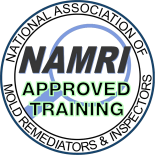|



National Certifying Body for Mold Professionals

|
 Get
Mold Certified Today Get
Mold Certified Today  My Account My Account 800-679-4381 800-679-4381 Enroll Enroll
PROFESSIONAL MOLD INSPECTION INSTITUTE
Mold Inspector / Mold Remediator Training and Certification
Mold Course Objectives
Each lesson starts by listing the objectives you will learn, followed by a short practice quiz to check your
prior knowledge. Below are the objectives that you will master in each lesson of the Mold Inspector Certification
Course.
- Introduction to Mold Inspection Terminology - Overview of the common language used throughout the mold
inspection industry by licensed mold inspectors
- Understanding Mold - Defining mold and its characteristics, how mold grows, the differences between
mold, mildew, and fungi, what is considered excessive mold, the causes of mold, defining mold remediation, understanding
spores and substrates, potential health hazards, hidden mold, recognizing areas affected by mold, toxic or unsafe
mold
- Effects on Humans - Harmful effects on humans, how mold attacks, the risks of inhalation exposures,
sensitization and allergic reactions, sinusitis, hypersensitivity pneumonitis, and other health problems, by-product
reactions, risks of ingestion exposures, techniques for treatment and prevention
- Effects on Homes - The cost of mold damage, the cost of mold remediation, molds effects on construction
and house furnishings, affects on the insurance industry, construction flaws that cause mold damage, where to look
for mold, warning signs of mold
- Mold Detection Equipment - How mold can be detected, common tools for mold inspections, where to inspect
for mold, mold related safety equipment, common signs & locations of mold infestations
- Mold Sampling - Methods of sampling for mold, types of equipment needed, determining the correct mold
sampling method, pros and cons of sampling types, tape sampling, swab sampling, bulk sampling, air sampling, safety
when sampling for mold
- Standards of Practice - The EPA's position on mold exposure, terminology used in mold standards, the
scope of a mold inspection and limitations, areas of the grounds, exterior, structure, plumbing, interior, and
HVAC which are to be inspected, areas excluded from a mold inspection, standardized procedures for collecting tape,
swab and air samples
- Grounds Inspection - Components and conditions outside the home and not part of the structure that include
grading, slope, erosion, close vegetation, general drainage, retaining walls, and water sources that can contribute
to microbial growth in the home
- Exterior Inspection - Components and conditions outside the home that are part of or connected to the
structure that include porch, decks, patios, steps, siding, windows, window wells, doors, eaves, soffits, gutters,
down spouts, flues and chimneys, that have deterioration or defects that can contribute to microbial growth in
the home
- Structure Inspection - Components that support or allow access to the framework of the home that include
the foundation, roof supports, floor and ceiling supports, columns or peers, exterior or load-bearing walls, the
attic, basement, crawlspace and garage, that have deterioration or defects that can contribute to microbial growth
in the home
- Plumbing Inspection - Components and related fixtures that are connected to the home's pressurized water
supply, waste pipes and ventilation pipes that include sinks, tubs, showers, drains, toilets and installed appliances
such as garbage disposals, dishwashers, washing machines and water heaters that have leaks, deterioration or defects
that can contribute to microbial growth in the home
- Interior Inspection - Components and conditions inside the home that include windows, doors, kitchens,
floor coverings, stairs, bathrooms, laundry, bedrooms, closets and other various rooms that show evidence of suspected
microbial growth, water damage, musty odors, dampness, insufficient ventilation, deterioration or defects that
can contribute to microbial growth in the home
- HVAC Inspection - Components related to the heating, cooling and distribution of a home's climate control
system that include the air supply and return boxes, boiler pipe system, humidifier, filters, ducts and vents,
condensate drain or pump lines that show evidence of suspected microbial growth, water damage, musty odors, deterioration
or defects that can contribute to microbial growth in the home
- Mold Reporting - Mold reporting methodologies, pre-inspection agreement, the inspection process, mold
report summary, interpreting lab results, reviewing the report with the client
- Mold Treatment - Understanding mold remediation, treatment methods, mold remediation techniques, containing
mold from spreading, killing and removing mold, protecting a remediated area against mold re-growth

30-Day Money-Back Guarantee

The only mold inspection and mold remediation training with a satisfaction guarantee!

©Professional Mold Inspection Institute (PMII). All rights reserved.
|






